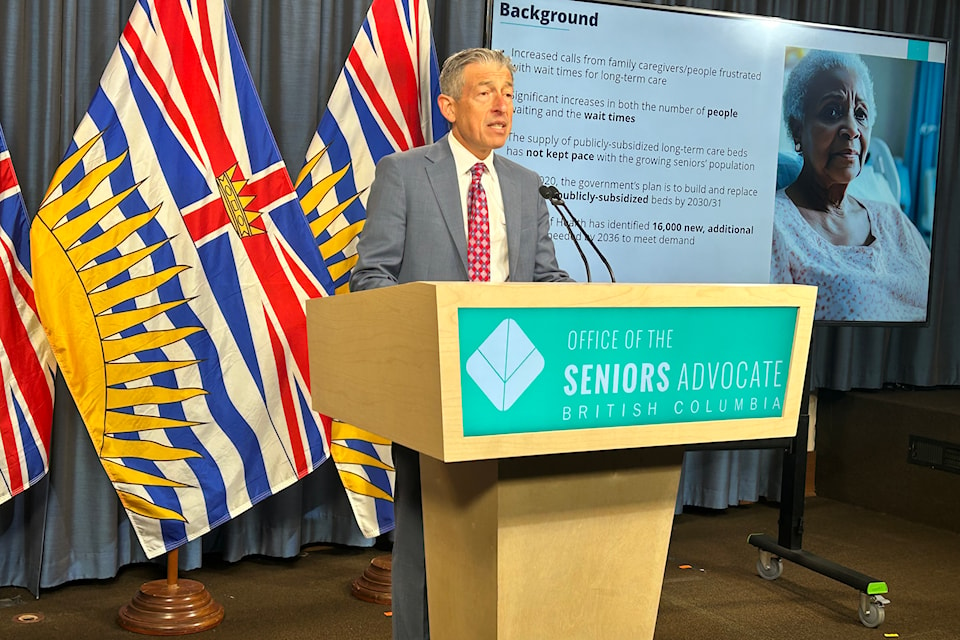B.C. Seniors Advocate Dan Levitt is warning that the province must act now to plan for additional long-term care beds for the growing population of British Columbians over the age of 75.
Otherwise, wait times will continue to get longer over the course of the next decade as the number of seniors grows, straining families and caregivers.
"We have to build 50 per cent more long-term care beds than exist today to meet the demand," Levitt said.
Levitt and his team studied the situation over the past ten years, finding that a decade ago, there were 77 beds per 1,000 people over 75. Today, there are 58 beds, and by 2035, Levitt said, this number could fall to 41. This is based on a projected 79-per-cent increase in the number of seniors over 75 in B.C. from 517,000 today to 772,000 by 2035.
Average wait times have gone from 146 days to 290 days on average over the past decade, while the overall number of people waiting for beds grew from 2,381 to 7,212.
Levitt presented the findings in Victoria on Tuesday, July 29, releasing his report 'From shortfall to crisis: Growing demand for long-term care beds in B.C.'
Not all seniors need long-term care, Levitt notes in his report, and many can live out their lives at home. Currently, about 35,000 require long-term care. This is expected to grow to 55,000 over the next decade.
Meanwhile, the province has committed to building 2,935 new public long-term care beds between 2025 and 2031. This is a 10-per-cent increase.
But there is already a 2,000-bed shortfall. If trends and building plans continue at the current pace, Levitt expects a shortfall of 7,000 beds by 2030 and 16,000 by 2025.
"Clearly, bed supply is not growing at the same pace as the target population," his report says.
This puts a burden on the adult children of seniors and their spouses, who are often left to care for family members waiting for long-term care beds.
"Caregiving is demanding and often expensive; care needs are getting more complex as people are living longer and spend more time in advanced age," Levitt's report says.
To overcome this shortfall would take significant investment. Levitt estimated the capital cost per bed to be about $1 million. These costs are often shared between the province and local regional districts. The operating cost for a long-term care bed once it is built is roughly $100,000 per year, he said.
Levitt recommends bolstering the whole system to improve care at all levels of need, while also adding beds. The goal would be to add capacity while also reducing the burden on the system by providing better home care and support.
This includes other stages of care outside the home that can be improved and expanded, such as supportive housing and assisted living arrangements.
Levitt also wants more transparency in how seniors are prioritized for long-term care spaces, along with a review of wait list management practices to develop new targets. This will help families plan and navigate the system better, the report says.
Currently, many beds are filled by seniors being moved from hospitals. This is a function of both prioritizing based on need and the desire of hospitals to clear space. Other people, who are still at home with family caretakers, are put lower on the list because they have a viable caregiver.
"Because we haven't made the kind of investment that's needed, we shifted the burden from government to the families," Levitt said.
Brennan Day, the B.C. Conservative critic for Seniors' Health, seized on the report as further evidence of the NDP government's failure on health care.
“Seniors aren’t getting the support they need at home, so they end up in emergency rooms instead, and our hospitals are buckling under the pressure,” Day said.
He added that the NDP should have seen this coming.
"The so-called ‘grey wave’ didn’t come out of nowhere; it’s been building for years, and this government still wasn’t ready,” he said.
Premier David Eby blamed the B.C. Liberal government that was in power before the NDP took charge in 2017.
"The hard part about this is that from 2007 to 2017, there were almost no long-term care beds built in this province, which is a shocking thing," he said. "But that was a set of decisions that were made by the previous government."
Eby said he welcomed the report and pledged to work on Levitt's recommendations. He also acknowledged that the work he has done so far is not enough.
"We have to add a lot more," he said.
